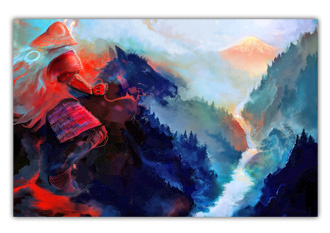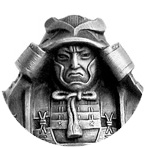Origin and Development of The Samurai
samurai history
-
Japanese history is full of fierce battles between warriors and various barbaric tribes. Between the 3rd and 4th centuries Japanese society was military-oriented. This is confirmed by artifacts found in graves, including swords, spears, and other weapons, as well as cultic figurines of warriors dressed in armor called haniwa. Even their throats were covered by their helmets and their hands rested on their sword hilt, ready to draw. There is no doubt that the martial spirit had deep roots in Japan.
Like in any other nation, the Japanese military class was formed to fulfill two missions: to maintain domestic order and ward off external threats. The transformation of the samurai into a class had been a long process which lasted almost five centuries, and was established even though Japan hadn’t faced any foreign threats for a long time. But to expand, the Japanese state had to force other tribes out. Active and systematic territorial expansion started when the centralized state took shape around 645 CE, the period of the rise of the samurai class.

While the establishment of the samurai class was promoted by the expansionist government and old military aristocracy or appointed nobles, there were also spontaneous elements. Hotheads and brave adventurers, which preferred dangers of combat to the tediousness of the plough, gathered at the borders where they found an outlet for their energy, war.
Their most aggressive adversaries were the Ainu – tribes of a different race who resembled the aboriginal people of Australia. They had extremely hairy bodies, were stalky and tall, and were generally physically stronger and had better endurance than the shorter and less vigorous Japanese. The Ainu mainly practiced hunting, fishing, and savagely plundering each other and their neighbors, a trait that earned them the moniker “courageous snow leopards.” In the event of defeat they would often commit suicide, and the women were known to kill themselves as well as their children. Furthermore, in a practice that was considered most unbecoming for a samurai, the Ainu would dip their arrows in poison that was so fatal; many samurai died just from being scratched. Needless to say, the threat of being attacked by the Ainu kept the Japanese on alert day and night.
The clashes with the Ainu lasted for hundreds of years and the samurai tasted victories and defeats. The war dragged on until the fall of the Ainu’s last stronghold, Hokkaido Island, in the 15th century. But in the long run, the Ainu were useful because they helped strengthen the samurai spirit and made it indomitable.
To control conquered territories, feudal lords needed permanent, well-armed squadrons. Initially they were both managed and financed by the central government, but as the empire grew, the imperial court gradually relinquished control of the provinces and shifted the responsibility of the squadrons to local feudal families. As their influence expanded, they became less submissive to the emperor and the Fujiwara, their blood relatives. Therefore, from the 10th century onwards, state power was becoming more and more precarious and separatist revolts abounded.

Fujiwara no Yasumasa Playing the Flute by Moonlight by Tsukioka YoshitoshiAn unlucky omen came in 1052 when a Buddhist sanctuary, the Haseji monastery, was consumed in flames. This event marked the beginning of the Age of Dharma Decline.1 The Japanese had been anticipating dreadful changes for a century. As early as in 936, a descendant of the Fujiwara clan, Fujiwara Sumitomo, incited a mutiny in Kyushu Island. Then, in 938, ruler of eight provinces and warrior leader Taira Masakado spearheaded a rebellion in the eastern part of the country. The samurai squadrons who were loyal to the government had to fight fiercely in order to quell these revolts. And because many squadrons were still under the command of the rebels, samurai fought against samurai. But the government’s victory was short-lived and did not deter future upheavals, nor did it have a military capable of withstanding the onslaught of the provinces. Instead, it used their samurai to pacify the other squadrons and essentially became a prisoner of the situation.
The court did not realize the significance of the rise of the samurai class. The Fujiwara were confident that they were masters of intrigue, unparalleled in their ability to outmaneuver and manipulate the backward, irrational, and unsophisticated samurai-provincials and pit them against each other to maintain power. They arrogantly believed that the country could not function without their orders because, naturally, they were spiritually and mentally superior. Even though it was in decline, the life of the court was still carefree and the courtiers looked down on those outside their small clique. This included the samurai, whose occupation was supposedly beneath them.
But the way the court viewed the world was far from reality... read further in the bookBack to the Blog
This is part of a chapter from Samurai: Ascension by A. R. Berg

